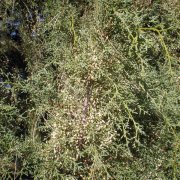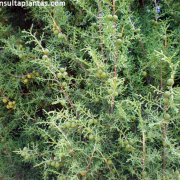Care of the shrub Juniperus phoenicea or Phoenicean juniper |
|
The Juniperus genus, Cupressaceae family, comprises 60 species of shrubs and trees native to the Northern Hemisphere. Some species are: Juniperus phoenicea, Juniperus oxycedrus, Juniperus horizontalis, Juniperus conferta, Juniperus communis, Juniperus chinensis, Juniperus californica, Juniperus osteosperma, Juniperus squamata, Juniperus drupacea, Juniperus thurifera, Juniperus x pfitzeriana (hybrid), Juniperus brevifolia. Common name: Phoenicean juniper. This species is native to the Mediterranean region. They are shrubs or evergreen trees branched from the base that reach 5 meters (16.4 feet) in height. The small scale-shaped leaves are grayish-green. The flowers are not decorative. They bloom in late winter or early spring. The fruits have a shiny surface and are reddish in color when ripe. These very slow-growing conifers are used in informal hedges, in bushy groups, as isolated specimens, and in pots for patios and terraces. Phoenicean juniper is ideal for forming windbreak screens in seaside gardens. Juniperus phoenicea grows in full sun or light shade exposures. It's very resistant to frost, wind and the intense heat of the Mediterranean summer. They can grow in any well-drained soil: sandy, limestone, acidic, saline, stony or poor. Transplantation or planting is done in autumn. Water moderately throughout the year waiting for the substrate to be completely dry. Juniperus phoenicea resists drought well. Phoenicean juniper does not need fertilizers or pruning. Juniperus phoenicea is a plant resistant to the usual pests but sensitive to excess humidity. Propagation is slow and complicated; It's advisable to buy new plants at nurseries, plant stores or garden centers. |
Images of the shrub Juniperus phoenicea or Phoenicean juniper |
Find plants
Juniperus phoenicea or Phoenicean juniper | Care and Growing
© 2026 FavThemes




